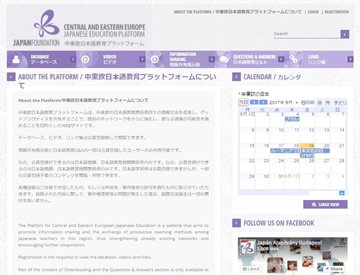Our Office Aims for “Connection,” and to Stimulate Exchange
The Japan Foundation, Budapest
HAYASHI Toshio, OMURO Fumi
The Japan Foundation, Budapest (hereinafter “JFBP”) supports Japanese-language education in 13 countries in Central and Eastern Europe (Poland, Romania, Bulgaria, Hungary, the Czech Republic, Serbia, Slovakia, Slovenia, Croatia, Bosnia & Herzegovina, Montenegro, Macedonia, and Kosovo); at the same time, we support Japanese-language education within Hungary and operate Japanese-language courses at the JFBP. In this article, Hayashi, who is in charge of the whole region of Central and Eastern Europe, and Omuro, who is in charge of Hungary itself, introduce their work.
Results of the Survey on Japanese-Language Education Abroad 2015
| Country | Poland | Romania | Bulgaria | Hungary | Czech Republic |
Serbia | Slovakia | Slovenia | Croatia | Bosnia Herze- govina |
Monte- negro |
Mace- donia |
Kosovo | Central and Eastern Europe 13 countries Total |
|---|---|---|---|---|---|---|---|---|---|---|---|---|---|---|
| 2012 | 3985 | 1905 | 1570 | 1554 | 825 | 292 | 252 | 208 | 125 | 0 | 0 | 0 | 0 | 10716 |
| 2015 | 4416 | 2052 | 1245 | 1992 | 1175 | 533 | 275 | 275 | 175 | 88 | 0 | 23 | 0 | 12249 |
According to the results report of the Survey on Japanese-Language Education Abroad 2015, which was made public in March 2017, the number of Japanese-language learners in Bulgaria went down by 325 between 2012 and 2015. However, this was the only one of the 13 countries in Central and Eastern Europe under the jurisdiction of the JFBP in which the numbers dropped. The survey was also able to confirm that there are new institutions in Bosnia & Herzegovina and Macedonia that offer Japanese-language education (although they are few in number). The survey wasn’t able to confirm the details of any institutions in Montenegro and Kosovo, but when former Japanese-Language Specialist MURAKAMI Yoshifumi visited Kosovo, around 70 learners who had been studying online courses attended his seminar on Japanese-learning methods. Since then, the activities of a Facebook group called “Japanese Language in Kosovo” have continued—it currently has 147 members. Supporting these kinds of autonomous learners is an important job in wide area support.
The Platform for Central and Eastern European Japanese Education
Up until now, the JFBP has run many different projects aimed at this wide region, including the Japanese-Language Education Network in Central and Eastern Europe and advisory activities carried out by Japanese-Language Senior Specialists. With the aim of sharing its accomplishments, strengthening collaboration, and creating joint projects, the JFBP began building the Platform for Central and Eastern European Japanese Education in FY2015; this went into full operation in FY2017. Only Japanese language teachers and people connected to Japanese-language educational institutions can register as members, but non-members can see content that is set for public viewing.

Users can publish information about members’ past achievements on the “Database” page. They can view videos relevant to Japanese-language education (seminars; research presentations; introductions to Japanese teaching materials, teachers, and educational institutions; interviews with Japanese-language learners, etc.) on the “Videos” page, and share materials related to Japanese-language education (symposium information, teaching materials, etc.) on the “Information Sharing” page. As long as registered users don't violate copyright, they can freely upload videos and materials on these pages. Other pages include “Questions & Answers,” “Links,” “Event Calendar,” and “FOLLOW US ON FACEBOOK.” Notably, there are already 73 videos focused on online learning as of May 2017, and these will continue to be available in the future.
The High “Quality” of Higher Educational Institutions
One characteristic of Central and Eastern Europe (in countries other than Bulgaria) is that an overwhelming number of Japanese-language learners in educational institutions are studying in higher educational institutions. Recently, there has been an increasing number of people who have become interested in Japan through Anime, Manga, and J-POP. However, in this region the main trend has been to study Japanese culture and history in a traditional manner based on literary scholarship, and so it is possible to feel students’ “devotion” to Japan, even to the point where it is abnormal. In addition, Japanese is extremely popular when it comes to foreign languages, and there is even a university boasting that its Japanese studies department is the second-most popular of all its philosophy and literature departments. As a result, it has become difficult to enroll in a Japanese studies department, and so these departments are gathering brilliant students.
The education system consists of three-year bachelor’s degree programs and two-year master’s degree programs, and once students are in their second year they generally carry out activities such as giving presentations on a variety of themes and holding discussions based on these. The surprising thing is the diversity of student interests relating to Japan, and the way they can organize and present these in a logical fashion and then hold academic debates about them. We should probably pay closer attention to the fact that these institutions are reliably fostering people who are knowledgeable about Japan, having received this high-quality education. (Hayashi)
Imparting the Practices of “JF Can-do for Life in Japan”
Six years have passed since the textbook “JF Can-do for Life in Japan” was published for Japanese-language learners in Hungary. In April 2017, this book was added to the national list of educational materials as a textbook for use in public education, meaning that it has definitely been acknowledged within the country. To date, the JFBP has run Japanese-language courses that make use of “JF Can-do for Life in Japan,” as well as creating mirror videos and supplementary materials such as Quizlet to enhance the environment in which learners use “JF Can-do for Life in Japan.” At the moment, the JFBP is focusing more effort on imparting information about the initiatives that it has built up. At the Japanese-Language Education Network in Central and Eastern Europe in February this year, Omuro gave a presentation about portfolio practices in classes using “JF Can-do for Life in Japan.” The exchanges that occurred after the presentation were rich with suggestions, and we want to aim for even better practice in Japanese-language courses for the next semester. The JFBP has also created a (private) Facebook group called “Japanese teachers who teach with ‘JF Can-do for Life in Japan’,” and is trialing sharing ideas for day-to-day lessons. Sharing these ideas creates discussions, and these are then reflected in each person’s practice—we want to continue imparting information so we can create this kind of environment.
Experiencing Japanese at Pop Culture Events!
“I am Tamás.”
In fall last year and spring this year, we participated in MONDO CON, one of the biggest pop culture events in Hungary, where we introduced the Japanese language on stage and ran a booth display. We used the “Japanese in Anime and Manga” site in our mini lessons, in which everyone enjoyed Japanese by becoming fictional characters. There were also people who told us they want to try talking to a Japanese person in Japanese! As a Japanese-Language Specialist, most of the people I get to meet are people studying Japanese at educational institutions. However, through this event I was able to hear the opinions of participants from regions that don't have Japanese-language educational institutions, and the opinions of people who are studying Japanese on their own.

The Japan Foundation has developed a variety of resources, including “JF Japanese e-learning Minato” and “JF Japanese e-learning HIRAGANA/KATAKANA Memory Hint”; I feel that connecting people in Hungary who are interested in learning Japanese with these resources is vital work. (Omuro)
- What We Do Top
- Arts and Cultural Exchange [Culture]
- Japanese-Language Education Overseas [Language]
- Japanese-Language Education Overseas [Language] Top
- Learn Japanese-language
- Teach Japanese-language
- Take Japanese-Language Test
- Know about Japanese-language education abroad
- The Japanese-Language Institute, Urawa
- The Japanese-Language Institute, Kansai
- Japanese-Language Programs for Foreign Specified Skilled Worker Candidates
- Japanese Language Education for Japanese Children Resident Overseas and for the Descendants of Migrants
- Archives
- Japanese Studies and Global Partnerships [Dialogue]
- JF digital collection
- Other Programs / Programs to Commemorate Exchange Year
- Awards and Prizes
- Publications
